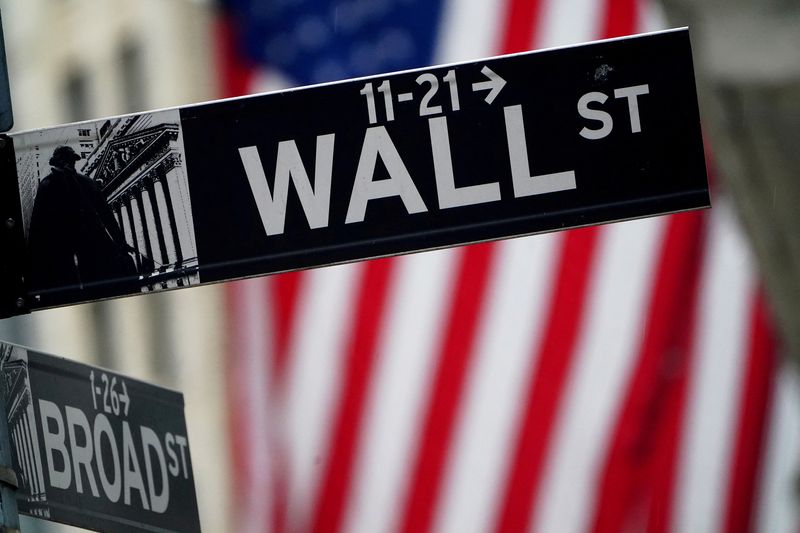By David Randall
NEW YORK (Reuters) -Bad news may once again be good news on Wall Street, as signs of slowing U.S. growth fan hopes that the Federal Reserve may not need to tighten policy as much as previously expected.
Home sales have fallen for a third straight month, while big misses from retail giants such as Target Corp (NYSE:TGT) and Walmart (NYSE:WMT) Inc shook their share prices last week. The Atlanta Fed's GDPNow estimate of real GDP growth for the second quarter fell to 1.8% on May 25, from 2.4% the previous week.
Softer economic growth raises risks of weaker corporate profits, in theory paving the way for softer share prices. Several Wall Street banks have in recent weeks warned that the chances of a U.S. recession are rising, along with an increased likelihood of the low-growth, high-inflation environment known as stagflation.
In the near-term, however, some investors believe a nascent slowdown could bolster the case for the Fed to pull back on an aggressive monetary policy tilt that has unnerved investors and helped drive the S&P 500 index to the cusp of the 20% decline that many call a bear market..
The index rose 6.6% this week, snapping a seven-week losing streak, though it is down around 13% for the year to date. Net weekly inflows to U.S. stocks stood at their highest level in 10 weeks, data from BofA Global Research showed Thursday.
"It's very clear that everyone at the Fed is on board for 50 basis-point (interest rate hikes) for the next two hiking meetings. But after that, it's unclear what they do, and if there is a sharp slowdown in growth, they may be able to wait a little bit," said Anwiti Bahuguna, senior portfolio manager and head of multi-asset strategy at Columbia Threadneedle Investments, who recently raised her allocation to equities.
Concerns over the impact of higher rates at a time when inflation may have peaked will likely mean the central bank will pause its tightening in September, leaving its benchmark overnight interest rate in a range of 1.75% to 2% if financial conditions worsen, BofA strategists said in a note.
Expectations of Fed hawkishness have eased, with investors now pricing in a 35% probability that the Fed funds rate will be between 2.25% and 2.50% after its September meeting, down from a 50% probability a week ago, according to CME.
The Fed has already raised rates by 75 basis points this year. Minutes from the central bank’s latest meeting showed officials grappling with how best to navigate the economy toward lower inflation without causing a recession or pushing the unemployment rate substantially higher.
Signs that growth may be slowing have helped bolster Treasury prices, suggesting investors are increasingly looking to bonds for safety rather than as assets that could be at risk during times of high inflation, said Anders Persson, chief investment officer of global fixed income at Nuveen.
Yields of benchmark 10-year Treasuries, which move inversely to prices, hit a six-week low of 2.706% on Thursday, after soaring to as high as 3.14% this month.
"The market is pricing in a slowdown," but not a recession, Persson said, making riskier parts of the fixed-income market, such as high yield bonds, more attractive.
U.S. data on Friday also showed price increases may be slowing. The personal consumption expenditures (PCE) price index rose 0.2%, the smallest gain since November 2020, after shooting up 0.9% in March.
A potentially less hawkish Fed is not necessarily a green light for equity buyers over the long term. With inflation at its highest in decades, concerns have grown over impending stagflation, a phenomenon that weighed heavily on all asset classes during the supply shocks of the 1970s.
Among those sounding the warning are hedge fund manager Bill Ackman, a member of the Fed’s investor advisory committee on financial markets, who on Twitter (NYSE:TWTR) this week urged the central bank to quell inflation by raising rates more aggressively.
Meanwhile, Citi's global asset allocation team this week cut its U.S. equity allocation to "neutral," saying, "While a U.S. recession is not the base case for Citi economics, uncertainty is very high."
Some investors, however, believe a turning point may be near.

Esty Dwek, chief investment officer at FlowBank, is betting the central bank will begin to see signs that inflation and growth are slowing by August, when policymakers hold their annual meeting in Jackson Hole, Wyoming.
"The Fed is past peak hawkishness," she said.